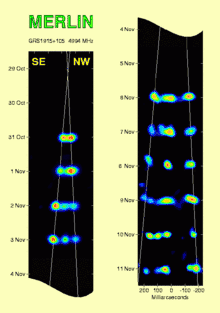GRS 1915+105
GRS 1915+105(或称天鷹座V1487)是由一顆规则恆星和黑洞組成的X射線聯星系,它於1992年8月15日被監視全天的Granat發現[3]。“GRS”缩写自“源自GRANAT(GRANAT source)”,“1915”代表着赤經19時又15分,“105”是指以0.1度為單位的赤緯(也就是赤緯是10.5度)。近紅外線的光譜也證實了此一觀測[4]。這個聯星系統位於天鷹座,距離11,000秒差距[5]。GRS 1915+105是銀河系內已知最重的黑洞[6],質量約在10至18倍的太陽質量[7]。它也是微類星體,並且這顆黑洞以每秒1,150次的速度高速自轉[8]。
| 觀測資料 曆元 J2000.0 | |
|---|---|
| 星座 | 天鷹座 |
| 星官 | {{{星官}}} |
| 赤經 | 19h 15m 11.6s[1] |
| 赤緯 | +10° 56' 44"[1] |
| 視星等(V) | |
| 距離 | 40.000 光年 (11.000 pc) |
| 光譜分類 | KIII[2] |
| 其他命名 | |
V* V1487 Aquilae, Granat 1915+105, NOVA Aquilae 1992, Granat 1915+10, INTEGRAL1 112. | |
銀河系的超光速源

一系列由MERLIN觀測GRS 1915+105數天的影像。
在1994年,GRS 1915+105的噴流成為所知的第一個銀河系內的超光速源[9]。
使用高解析度的電波望遠鏡,如甚大天线阵、MERLIN和甚长基线干涉测量等的觀測设备,顯示出在兩極噴出無線電頻率的同步輻射雙極帶電粒子流。這些研究顯示實際速度約為光速90%的噴流,明顯的有著相對論效應所謂的相對論性畸變超光速運動[5]。
成長的控制
回顧錢卓X射線天文台過去十年的觀測顯示,GRS 1915+105似乎有自我控制成長的機制。噴流噴出的物質不定期的會被由吸積盤吹出的熱風截斷,這陣風剝奪了維持噴流所需要的材料。當風沉寂時,噴流就返回了[10]。
參考資料
- Liu, Q. Z; Van Paradijs, J; Van Den Heuvel, E. P. J. . Astronomy and Astrophysics. 2007, 469 (2): 807. Bibcode:2007A&A...469..807L. arXiv:0707.0544. doi:10.1051/0004-6361:20077303.
- Abubekerov, M. K; Antokhina, E. A; Cherepashchuk, A. M; Shimanskii, V. V. . Astronomy Reports. 2006, 50 (7): 544. Bibcode:2006ARep...50..544A. arXiv:1201.4689. doi:10.1134/S1063772906070043.
- Castro-Tirado, A. J; Brandt, S; Lund, N. . IAU Circ. 1992, 5590: 2. Bibcode:1992IAUC.5590....2C.
- Castro-Tirado, A. J; Geballe, T. R; Lund, N. . Astrophysical Journal Letters. 1996, 461 (2): L99. Bibcode:1996ApJ...461L..99C. doi:10.1086/310009.
- Fender, R. P; Garrington, S. T; McKay, D. J; Muxlow, T. W. B; Pooley, G. G; Spencer, R. E; Stirling, A. M; Waltman, E. B. . Monthly Notices of the Royal Astronomical Society. 1999, 304 (4): 865. Bibcode:1999MNRAS.304..865F. arXiv:astro-ph/9812150. doi:10.1046/j.1365-8711.1999.02364.x.
- . [2017-11-25]. (原始内容存档于2020-10-26).
- Greiner, J. : arXiv:astro–ph/0111540. 2001. Bibcode:2001astro.ph.11540G. arXiv:astro-ph/0111540.
- Jeanna Bryne. . space.com. [2017-11-25]. (原始内容存档于2021-01-25).
- Mirabel, I. F; Rodríguez, L. F. . Nature. 1994, 371 (6492): 46. Bibcode:1994Natur.371...46M. doi:10.1038/371046a0.
- (新闻稿). NASA. 2009-03-25 [2009-04-16]. (原始内容存档于2017-07-09).
- Reid, M. J; McClintock, J. E; Steiner, J. F; Steeghs, D; Remillard, R. A; Dhawan, V; Narayan, R. . The Astrophysical Journal. 2014, 796: 2. Bibcode:2014ApJ...796....2R. arXiv:1409.2453. doi:10.1088/0004-637X/796/1/2.
外部連結
- A Very Massive Stellar Black Hole in the Milky Way Galaxy November 28, 2001 (ESO)
- Simbad 页面存档备份,存于
- Image V1487 Aquilae
- O maior buraco negro estelar da Via Láctea (The biggest stellar black hole of the Milky Way) 页面存档备份,存于 - in Portuguese.
- GRS 1915+105页面存档备份,存于
- MICRO-QUASAR WITHIN OUR GALAXY
- Image The IBIS/ISGRI 20-40 keV ( width and height) image, showing the location of GRS 1915+105 and three other bright sources in the field, including the new transient IGR J19140+098 discovered during this observation. North is up and East is to the left.
- A SPI 100-200 keV image of GRS 1915+105. GRS 1915+105 is clearly visible at the center of the image (marked). The three other sources seen in Fig. 2 are much fainter in this energy range and not visible.
- The micro quasar GRS 1915+105
This article is issued from Wikipedia. The text is licensed under Creative Commons - Attribution - Sharealike. Additional terms may apply for the media files.